Brief

The consumer is sovereign
From tracking drivers’ braking behavior to installing wearable devices on factory workers and funding medical-advice mobile apps, many insurance companies are trying to become more present in their customers’ lives. They know that improving the long-term economics of the business will require interacting more and delivering more value to customers. A customer-centered approach has finally gained the attention of many insurance executives as an alternative to the traditional, internal focus on products, agents and in-year financial considerations.
What accounts for this shift in perspective? The low-interest-rate environment has depressed investment returns for paid-in premiums, and in mature markets, there has been almost no growth in product penetration, forcing insurers to rethink their economic models for their core businesses. Regulators in some countries, including the UK and Australia, have also been questioning whether fee structures for financial advisers generate acute conflicts of interest that harm consumers. These macroeconomic and regulatory forces make earning customer loyalty more important now than ever.
More broadly, many executives now realize that a business built around customer loyalty and advocacy can yield substantial long-term benefits. Customers who are loyal promoters of their insurers stay longer, buy more, recommend the company to friends and family, and usually cost less to serve, Bain & Company analysis shows, with the mix of these forces dependent on the particular market and type of insurance.
Bain’s new survey of 164,421 consumers in 19 countries, through Research Now, sheds light on how various customer segments perceive their P&C and life carriers, what customers want from their carriers and how different distribution and interaction channels influence loyalty.
The survey data shows that loyalty remains tough for many insurers to come by. One structural reason is that insurers have far fewer interactions with customers than, say, retail banks. In some markets, interactions are even dwindling with the rise of online aggregators (also known as comparison sites).
Another reason stems from the fact that most insurers don’t have or have just begun to install a full-fledged system to analyze their customer feedback and take actions that will improve customers’ experience. Feedback that doesn’t lead to action is meaningless.
In some of the countries surveyed, though, one or two carriers in life and P&C manage to excel in earning consumers’ advocacy. Most loyalty leaders have found ways to generate more meaningful interactions by redefining what it means to be a provider. For example, HUK-Coburg, the loyalty leader in Germany, has continually redefined its value proposition around auto insurance since launching its network of partner car repair shops in 2005. Over the years since then, it has improved its claims experience and added services such as inspections, all at attractive prices.
While earning loyalty is necessary, it is insufficient for generating superior revenue growth. Insurers must also motivate customers to actively promote the company and learn to monetize loyalty. Bain’s new survey analysis and our work with insurance companies worldwide suggest four important themes for insurers to keep in mind as they build out a customer-centered distribution and service model.

How Insurers Can Improve Customer Loyalty
Many insurers struggle to earn customer loyalty. However, insurers can boost loyalty by offering services beyond traditional coverage and focusing on mobile.
Fight to get closer to the customer
Being in touch more frequently with consumers contributes to loyalty, in both the life and P&C sectors. The level of contribution varies—with France and Spain at the low end and China, Indonesia and Malaysia at the high end—but it is significant in every country surveyed. Interactions that are complex and attract more multichannel behavior, such as getting advice and a quote on a life insurance product or initially filing a claim, have the biggest potential to delight customers. But even raising the number of simple digital interactions can advance the cause of loyalty; as a bonus, each interaction allows an insurer to learn more about the individual consumer and to set the stage for customized future offerings.
Current digital tools, moreover, expand the universe of possible interactions. Links between insurers’ IT systems, customers’ smartphones and connected devices in cars, homes and workplaces now enable more product and service innovations, not just a convenient channel to interact through.
That universe includes a range of services that extend well beyond traditional insurance coverage. A large share of consumers in our survey expressed interest in such services, and an even larger group would be willing to share their financial, health or other personal data with insurers. These findings signal consumers’ trust in their carriers, opening the door to stronger relationships with customers.
A strategy of adding services might not strictly aim to raise revenues, but rather to deliver value by earning greater loyalty and lifetime value of customers. Some insurers are starting to create an ecosystem of such services, with emerging initiatives taking many forms:
- AIG has invested in Human Condition Safety, a technology start-up developing wearable devices, analytics and systems to improve worker safety. These tools help workers, managers and worksite owners prevent injuries in manufacturing and construction.
- AXA Germany has teamed up with RWE, using RWE’s SmartHome automation system to minimize flood damage and provide fast support—an example of AXA’s stated shift “from payer to partner.”
- Many ancillary services for drivers depend on a telematics box installed in the vehicle (see Figure 1)—for example, a street-sweeping alert from Metromile and stolen-vehicle tracking and recovery from Discovery.
- A few insurers have experimented with “gamification” and found that it stimulates customer engagement in vertical markets such as auto and health. In South Africa, Discovery used a mobile app developed by Cambridge Mobile Telematics for a nationwide safe-driving contest, in which tens of thousands of drivers competed for prizes. Findings show that safe driving increased by more than 30% during the contest.
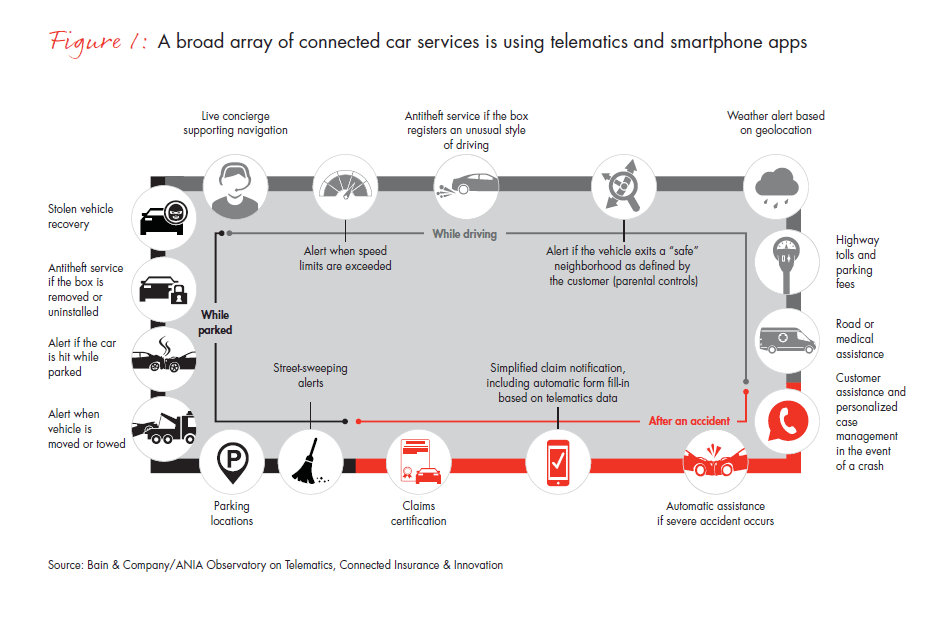
Competition has intensified as fintechs redefine how customers experience insurance and aggregators and brokers interact directly with consumers. Expanding services—often in concert with third-party providers—offers a powerful means for insurance providers to use their customer assets so they don’t get sidelined into the lower-value role of a utility.
Fix the basics and accelerate the mobile channel
Customers want to be able to use the channel that’s convenient to the moment, whether that’s a website, an in-person meeting, a phone call, a video chat with an agent or, increasingly, a mobile device. The expectation of using any channel pervades all customer segments, regardless of age, income or insurance needs. And the share of consumers using digital channels to complement other channels keeps growing: almost one-third of consumers in Hong Kong and two-thirds in mainland China now use digital channels when purchasing a P&C product.
Mobile’s role, in particular, continues to expand though it’s well below what many banks have offered their customers. As a quick indicator, consider that when Bain asked consumers if they would miss more their mobile phones or physical wallets for a day, more than half chose their phones, with the share reaching 79% in China (see Figure 2). Mobile clearly has advanced past the tipping point, though the rate of adoption varies significantly among countries. Multinational companies thus will need a thorough understanding of the digital dynamics in each country of operation; they cannot simply roll out a mobile app worldwide.
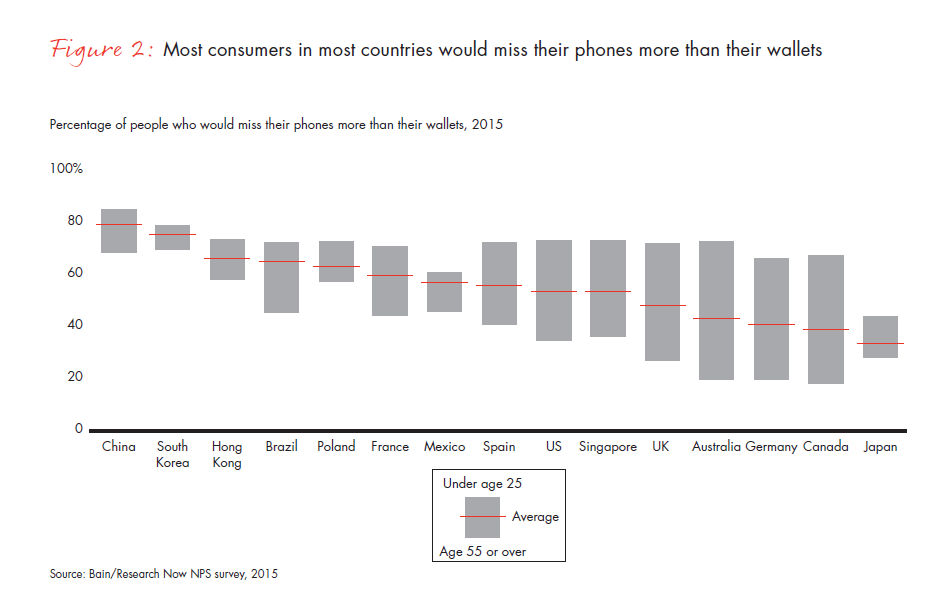
Companies that get mobile design right can reap huge benefits. Our survey shows that mobile can create delight among customers in many countries (see Figure 3).
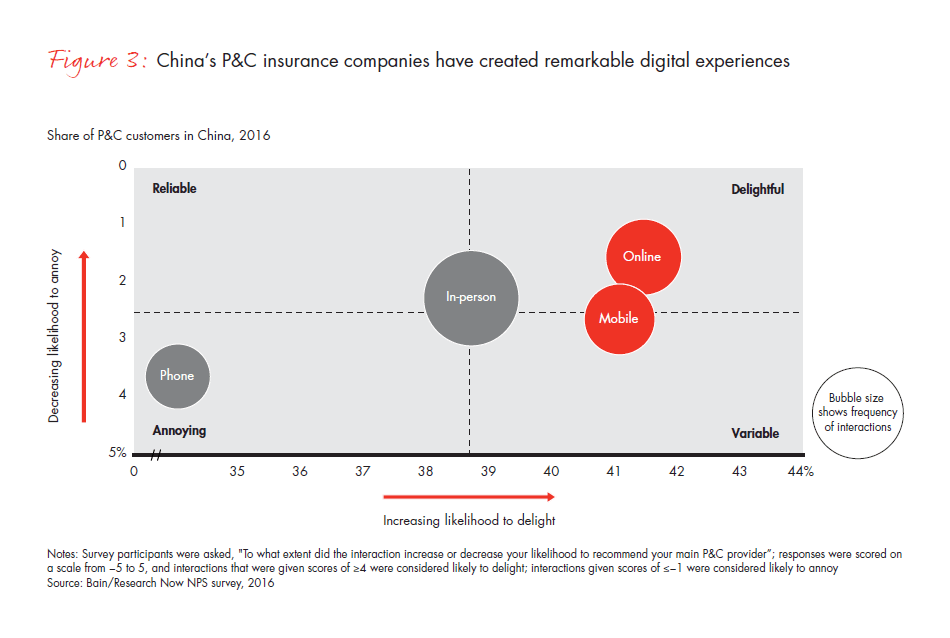
Some of the most creative and promising mobile apps originated in China. For example, Ping An, one of China’s largest insurers, in 2009 launched the first online financial management service in China, linking customers to dozens of websites, including insurance, banking, payments and airlines. More recently, it built a mobile platform called Ping An Good Doctor, which now has 77 million registered users and more than 50,000 doctors on board.
Mobile-led service provision allows insurers to differentiate themselves from competitors. But the loyalty leaders also excel at the basics of business: accuracy, reliability and ease of use in every channel and during every interaction.
Mastering the basics—engaging customers seamlessly across channels—requires coordination among different functions within the organization. It’s critical to have a unified, complete view of the customer across all business lines, which can be a challenge for traditional insurers, whose underwriting, claims, marketing, sales and call-center departments make their own investment decisions and whose different businesses, such as P&C, life and health, operate separately. Another common challenge stems from underinvestment in mechanisms to ensure that the customer interactions in one channel flow through to the other channels. Isolated, uncoordinated investments create major inefficiencies and make for a disjointed customer experience. To deliver a seamless experience, these walls must come down.
Raise the game in customer acquisition and retention
Performance on acquisition and retention of customers varies widely among P&C insurers—and only a very few companies excel at both, our survey shows.
That’s true for several reasons. Acquisition leaders tend to attract customers who are highly price sensitive and thus more likely to defect when they are presented with a lower-priced offer; price-sensitive customers in the US have a defection rate of 2.6 times that of other customers. Customers of acquisition leaders tend to be younger and lower income, and have fewer insurance needs. These companies spend more on advertising, and some skew toward direct distribution channels, using no or few agents. Their structurally lower expense ratios allow them to deliver on a low-price promise.
By contrast, companies that lead in retention have more customers who value peace of mind. Their customers tend to be less price sensitive, older and more affluent, and have more complex insurance needs. One payoff for these companies is that retention correlates strongly with higher loyalty.
The acquisition-retention divide often gets reinforced by company culture and business model. Some firms have set up to excel in acquisition with a low-cost, convenient, advertising-heavy, direct-to-consumer business model. Such P&C firms may have a more difficult time with customer retention given that the customers they attract tend to be more price sensitive and more prone to switching in the future.
Whatever an insurer’s initial tendency, a few practical implications flow from our survey:
- Refine marketing campaigns to be more selective in choosing customers. Attracting only price-sensitive customers will likely generate higher churn down the road, so carriers that take this route will have to continually manage costs down to attract an outsize share of new customers and maintain their market positions. As the advertising arms race escalates, there may come a point of diminishing returns, so insurers should make advertising and direct marketing more effective today.
- Use advanced analytics to improve consideration among less price-sensitive segments. Once the customer is on board, intensify tailored marketing to provide services and information that customers value or to reassure them that “we’ve got your back.”
- To boost conversion of new prospects, make it easy for people to find the right information, get a quote or get confirmation. While instant online quotes now are routinely offered in auto lines in some countries, online quotes have only begun to appear for home coverage. Agents or contact center reps should also follow up with people who abandon online applications.
- To help improve retention, build predictive models that better match tailored products to target segments. USAA, for example, mines customer data to inform targeted marketing that is triggered by a life event, such as offering additional auto insurance to a family when a child turns 16. Few insurers systematically track such triggers: Bain’s digital insurance benchmarking study in 2015 found that fewer than 50% of P&C carriers and 35% of life carriers track any customer buying signals (such as buying a house or car) using digital technologies.
- Invest in delighting, not simply satisfying, customers at key moments of truth. In P&C, claims handling offers a huge opportunity to delight. Some carriers, for instance, have achieved greater loyalty and retention by developing a network of certified auto repair centers that provide higher-caliber repair at lower cost.
Retention rates often can be raised through some straightforward tactics, not expensive new capabilities. Consider recent changes at Farmers, a US multiline insurer. A few years ago, its operating model was geared to acquisition, and the company was losing up to 25% of its customers every year. Stepping back to examine why, Farmers learned that its top-decile customers were worth significantly more than those in the bottom decile, and what accounted for that difference was customers’ tenures with Farmers and the number of policies they held. Yet Farmers had no loyalty program for its long-time customers.
Farmers turned its attention to creating better experiences, focusing on its highest-value customers. For example, key drivers of defection were a complex pricing system and poor communication around renewal pricing. A household that had six policies with Farmers could go through 6 to 12 renewal periods in a year, each with its own notice of price change—yet no explanation of why the price moved. Armed with this knowledge, Farmers recently refined its scripts and communications for agents and call centers, and is testing innovative price-stabilizing products that received early positive feedback.
Expand your share of wallet
One of the most effective methods to retain more customers is to sell them more products. Customer churn drops sharply as an insurer sells customers another one or two products, our survey finds. And many insurance firms have ample room to expand their share of the customer’s wallet. A large group of life insurance customers, particularly in Asia, expressed a need for more products or more coverage, and would likely buy from their primary insurers. Finding profitable growth through current customers typically is less expensive and yields a higher return on investment than acquiring new customers.
Fortunately for marketers, some of the barriers to cross-selling have fallen in recent years. The proliferation of customer data with rich contextual information and greater computing power to analyze this data make it feasible to learn more about customers, create more compelling value propositions and target with more precise offers at the most opportune time.
Here again, insurers can use a variety of tactics. Some tactics are relatively basic, such as adding a sales component to inbound calls, freeing up time for agents to actually sell or offering online diagnostic tools that show consumers how to optimize their coverage. In the UK, Admiral gives customers and their immediate family members a strong incentive to insure their cars with the company. Even if family members reside at different places, they can be insured on one policy and receive Admiral’s MultiCar benefits and discounts. Customers have insured more than 3 million cars through this program since 2005.
Other tactics depend on more sophisticated analytics techniques, such as automatically generating a next-best offer or integrating the insurer’s P&C, life and health customer databases in order to see which products are consumed by a single household. In the US, Progressive uses analytically optimized pricing to raise cross-selling rates, and it prepopulates renewal application forms with discounts for customers adding products. Some 40% of Progressive customers have both auto and home insurance, and an average lifetime value that is two to four times as high as customers with only one product.
Executives committed to raising their cross-selling and upselling rates should first ask, which of our products are lagging—for example, how many of our auto policyholders don’t hold a second product, and how does that compare with the market leader? Answering this question determines the priorities in terms of product and customer segment. Second, executives should ask, what tactics can we use to reach our target?
Harshveer Singh, a partner with Bain's Financial Services practice, discusses how insurers can get closer to their customers and sell more products to individuals and families.
• • •
Consumer sovereignty has only grown stronger with choices for less expensive insurance coverage just a few clicks away. But most consumers don’t want to defect. To the contrary, they often want to simplify their lives and do business with a single company that gives them reasons to stay. For most insurers, then, reigniting organic growth involves a heightened focus on earning customers’ loyalty by understanding their needs, interacting with them more intensely and delivering more value in the core insurance offering, and beyond. Digital tools now allow companies to get there faster, at scale and with more precision.
1. The imperative to earn greater loyalty
- Most insurers, especially in the life sector, rarely interact with customers—a major impediment to earning loyalty. Being in touch with customers has a large positive effect on loyalty, for both life and P&C.
- Across all of the countries analyzed, there is a significant gap between loyalty leaders and laggards—up to 60 points and 80 points in the P&C and life sectors in the US, respectively. Many of the leaders in 2014 continue to lead today: in the P&C sector, for example, Liverpool Victoria in the UK and HUK-Coburg in Germany; in the life sector, USAA in the US and Prudential (UK) in some Asian markets.
- Many customers trust insurers to serve them beyond basic coverage, as providers of platforms offering ancillary services related to car, home, health and life. These services range from auto sales and leasing sites to fitness club memberships and flood monitoring in home basements. Many involve partnerships with third parties.
- Of those customers who value such services, about 50% in Germany and 80% in South Korea and France view their primary insurers as potential platform providers.
- Furthermore, most customers would share their health, financial and other personal data with insurers. About 60% of customers in Japan and 95% in China are willing to share at least one type of personal data.
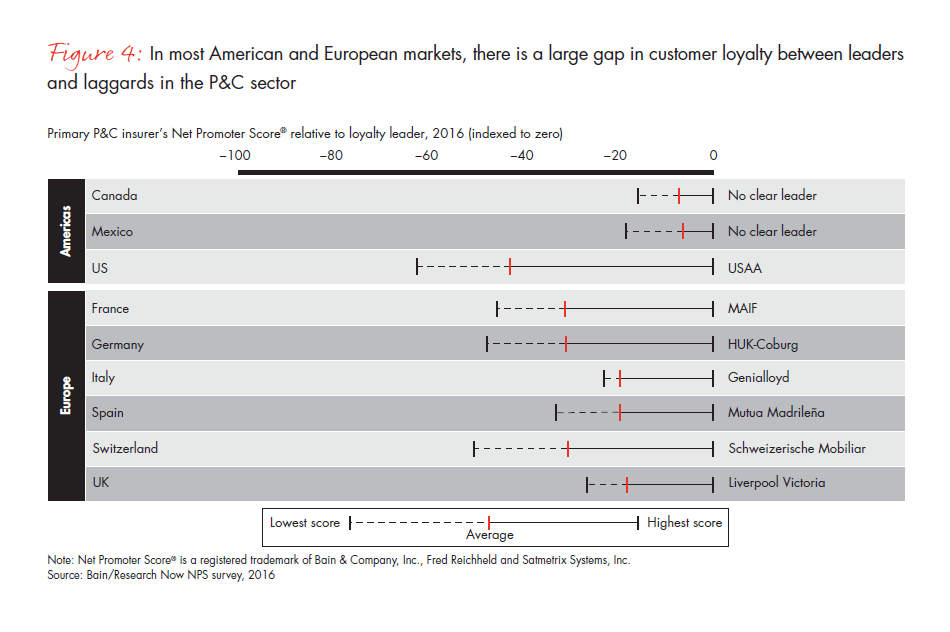
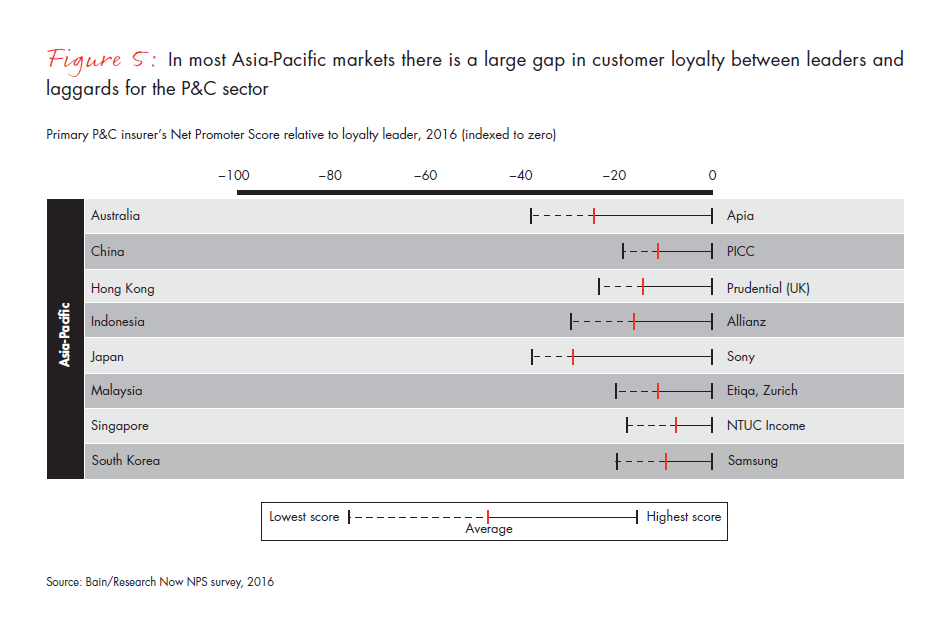
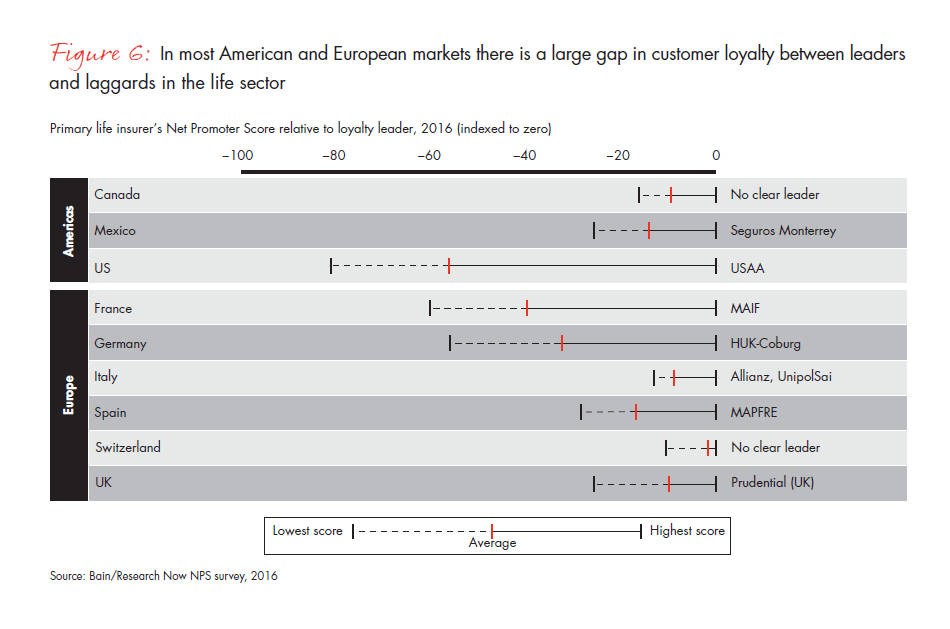
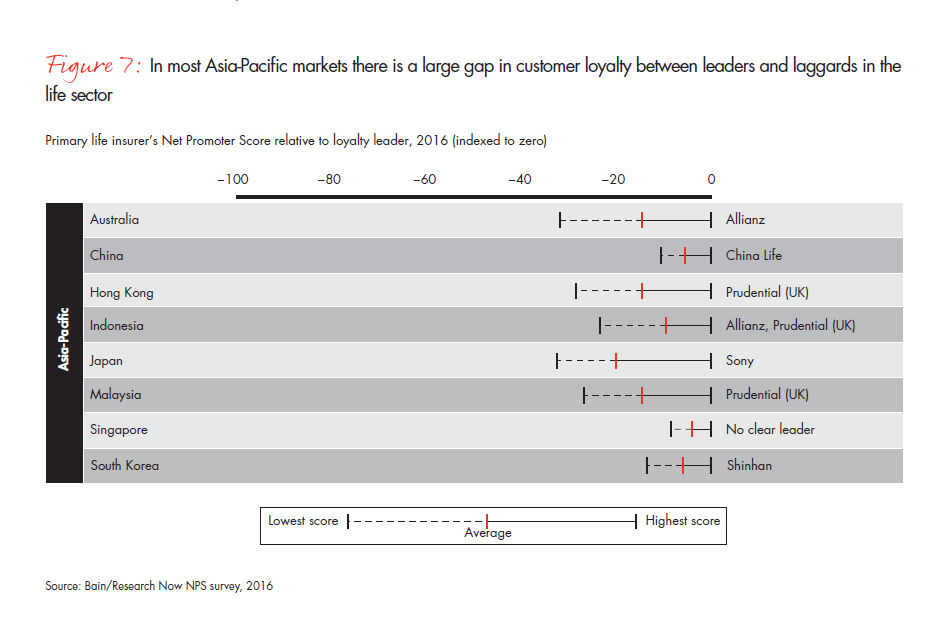
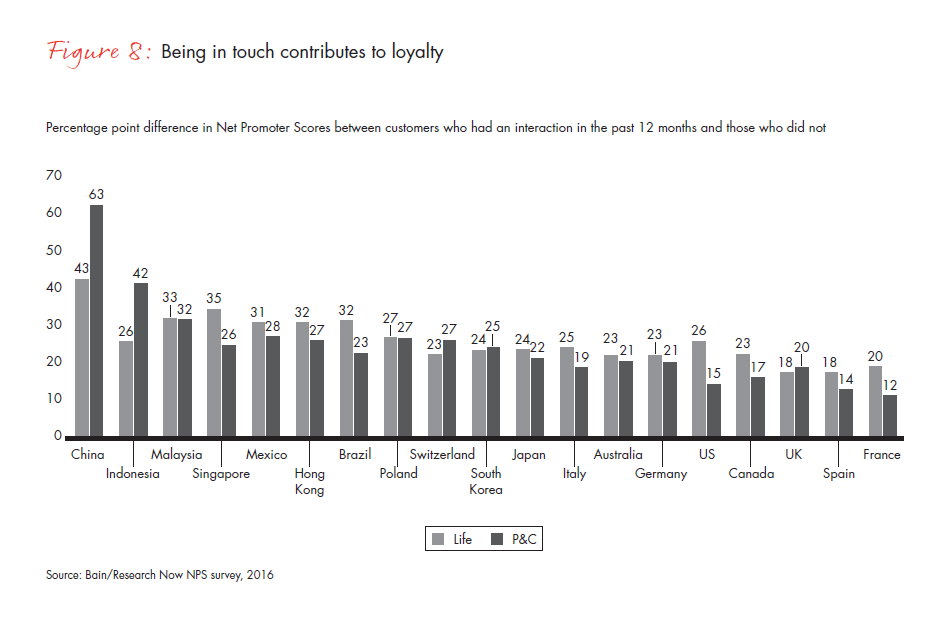
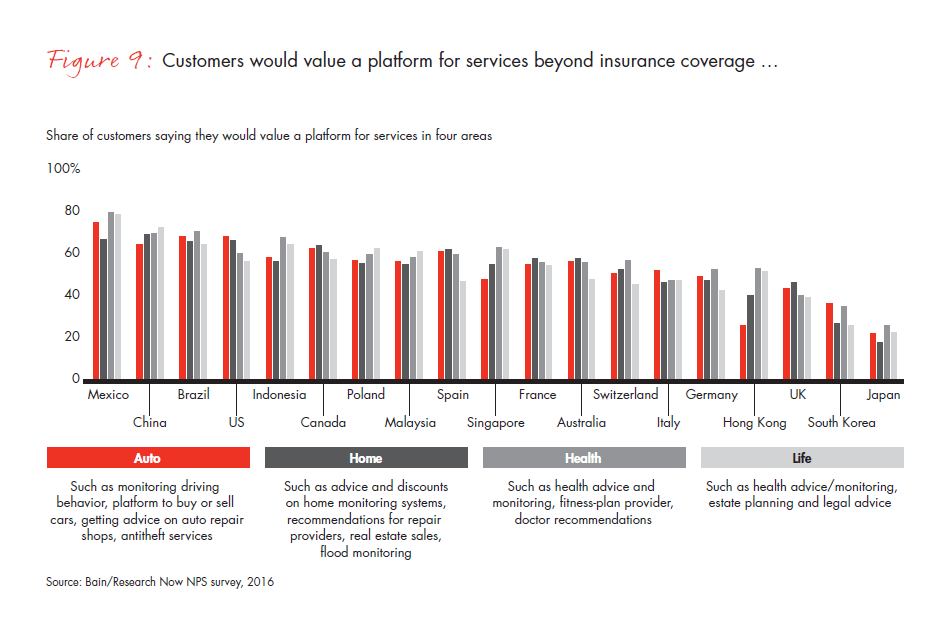
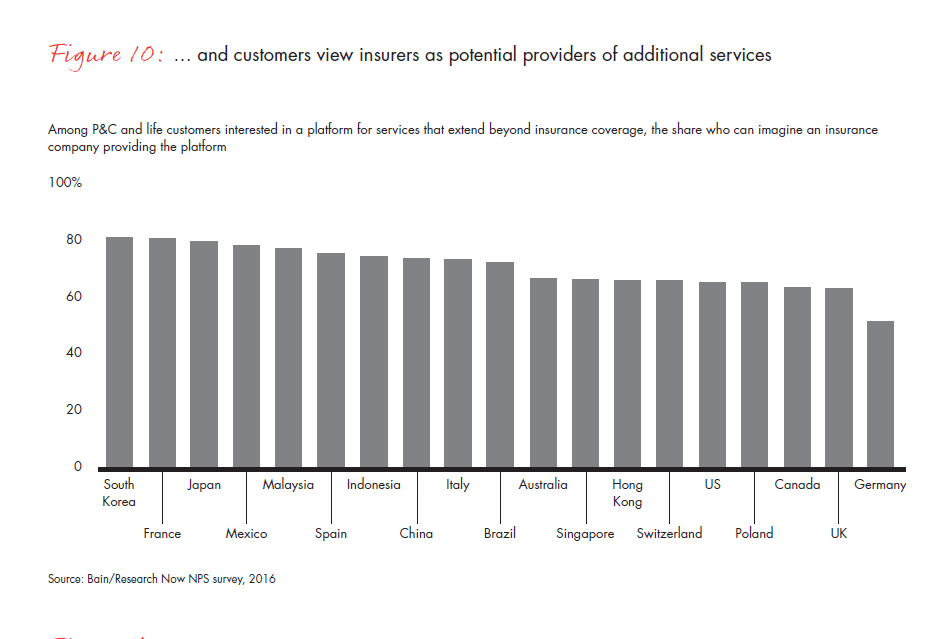
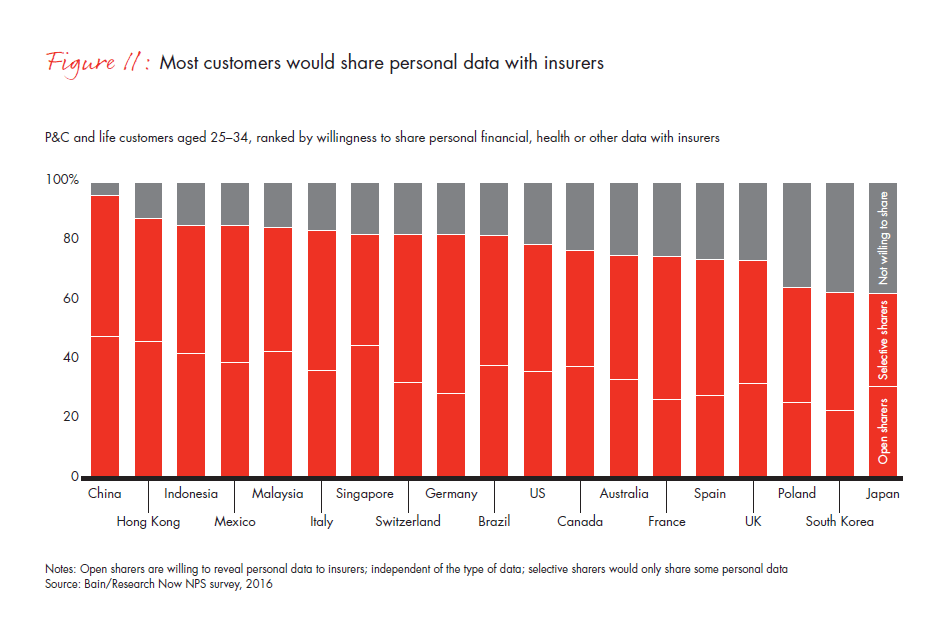
2. Creating delight through mobile
- Customers are increasingly embracing digital channels, both online and mobile, for their insurance interactions. The share of digitally active customers has increased everywhere over the past two years, though the rate of change varies by country. China, Brazil and Mexico have seen the greatest growth in digital use.
- Digital does not replace other channels but rather complements them, as customers are using more channels than they did two years ago. Digital raises the level of interactions, and a significant share of customers now use digital channels for purchasing P&C products.
- Multichannel interactions tend to be more effective in garnering loyalty. In most countries, digital-only customers give lower loyalty scores than customers who use phone-only, in-person or multiple channels. Customers want easy, fast, convenient websites and mobile apps, and few insurers have been able to design digital tools that meet these expectations.
- Mobile usage is coming on strong, however, even outpacing online usage in some Asian markets, such as Singapore, Hong Kong and Australia. And despite the low loyalty scores for digital on average, mobile offers huge potential to delight, especially for claims. Among some loyalty-leading companies, for example, customers give the highest loyalty scores for their mobile experience. USAA, whose banking arm invented remote check deposit in 2009, has been in the forefront of mobile innovation, in large part because it serves members of the military who are deployed to bases around the world.
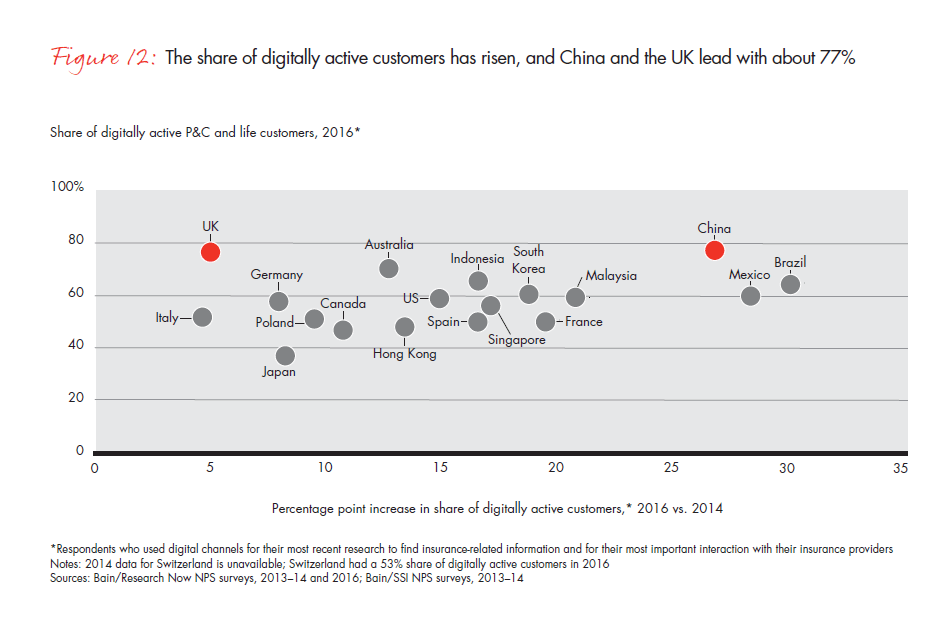
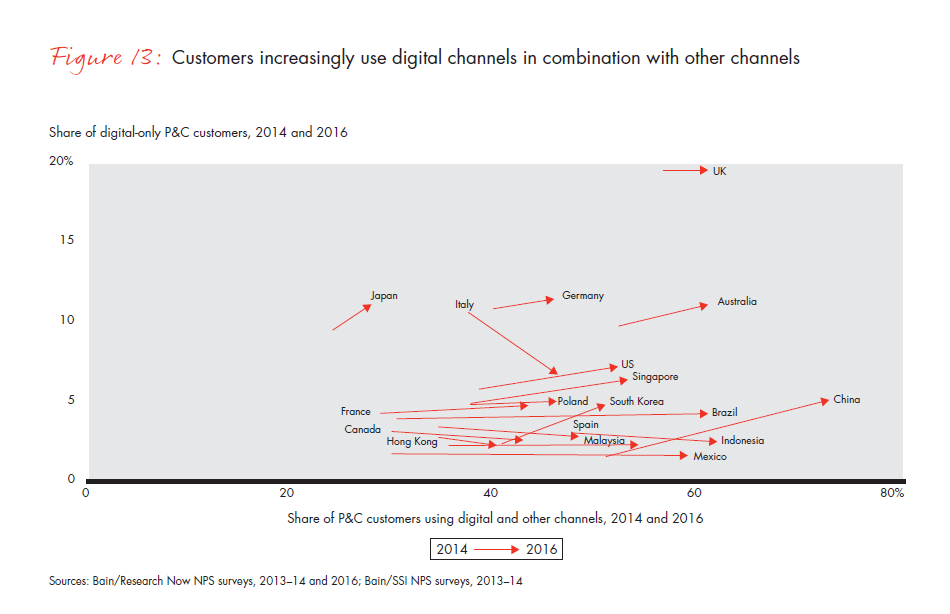
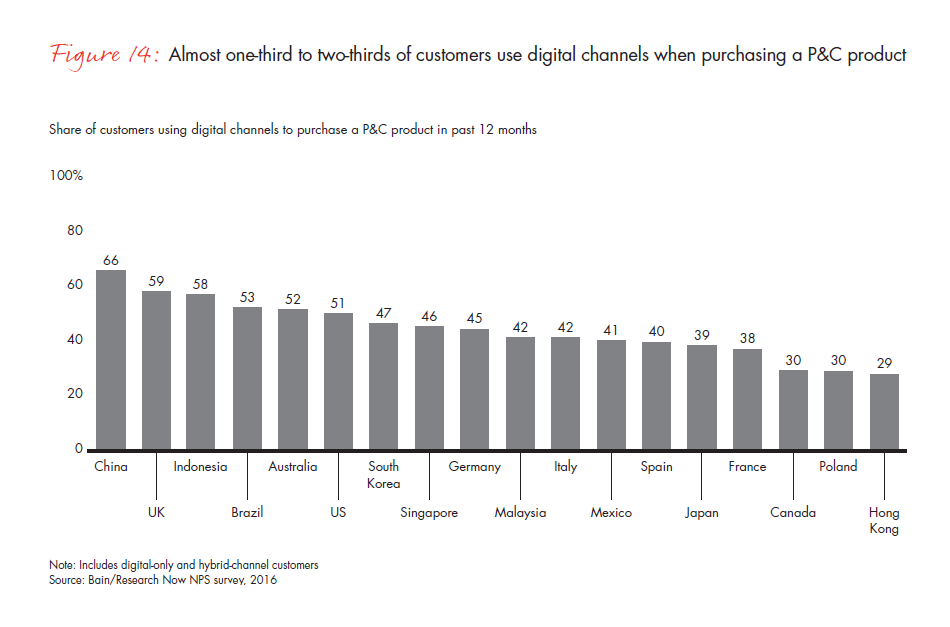
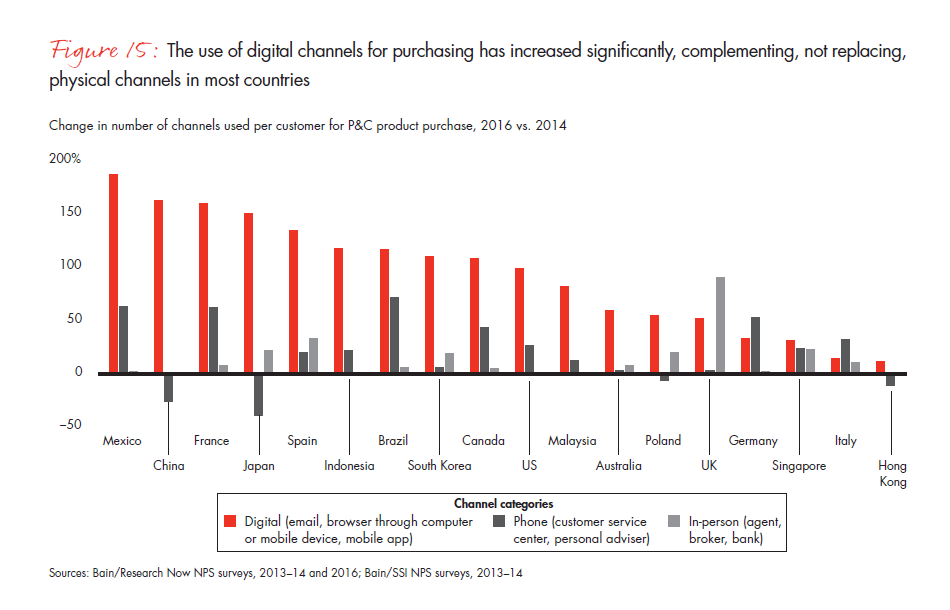
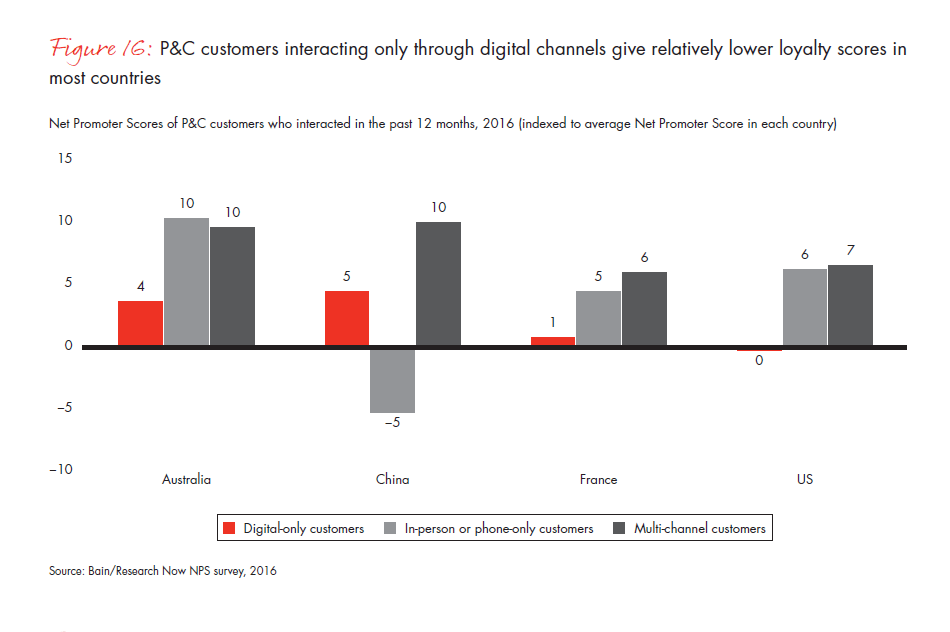
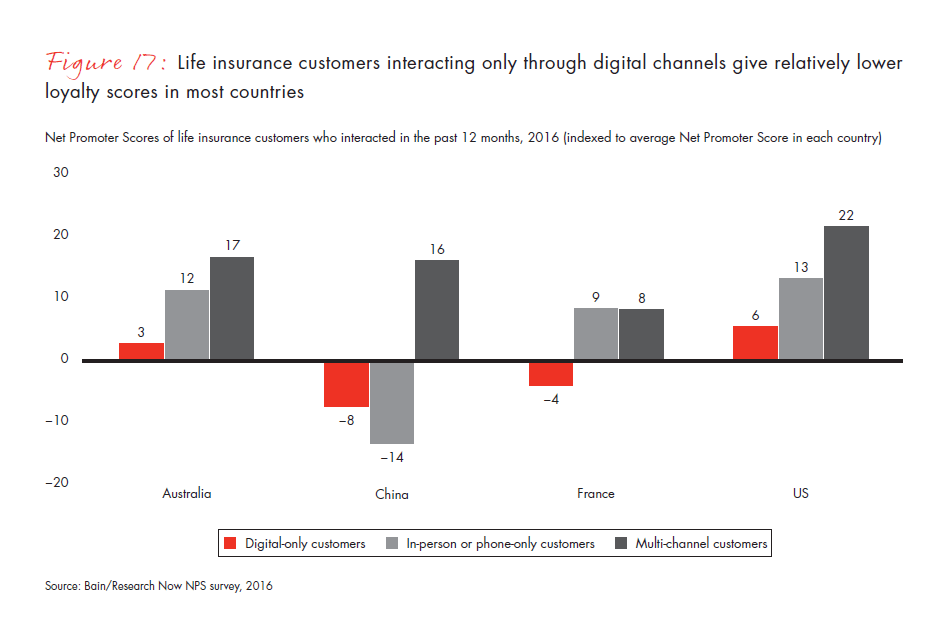
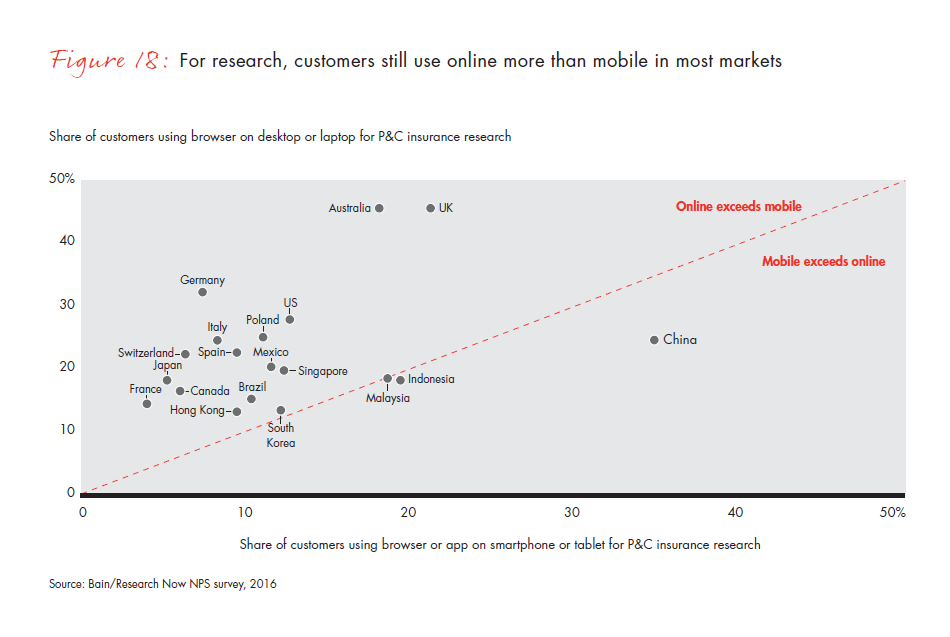
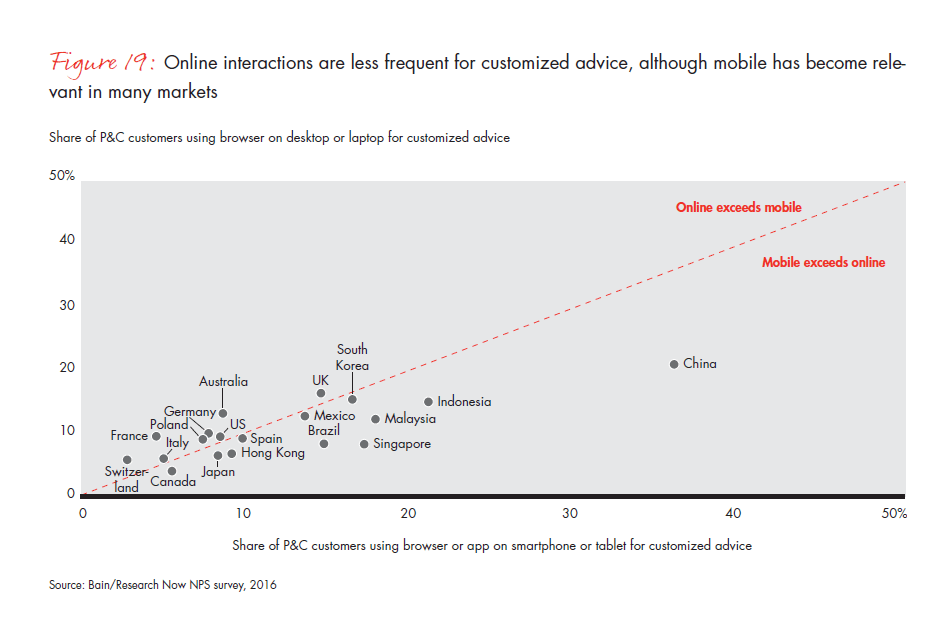
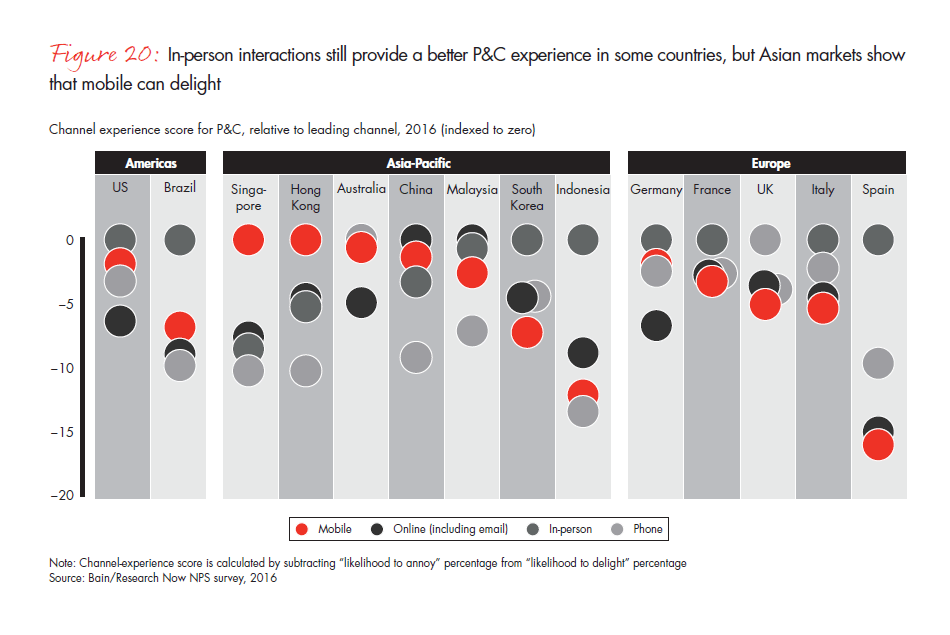
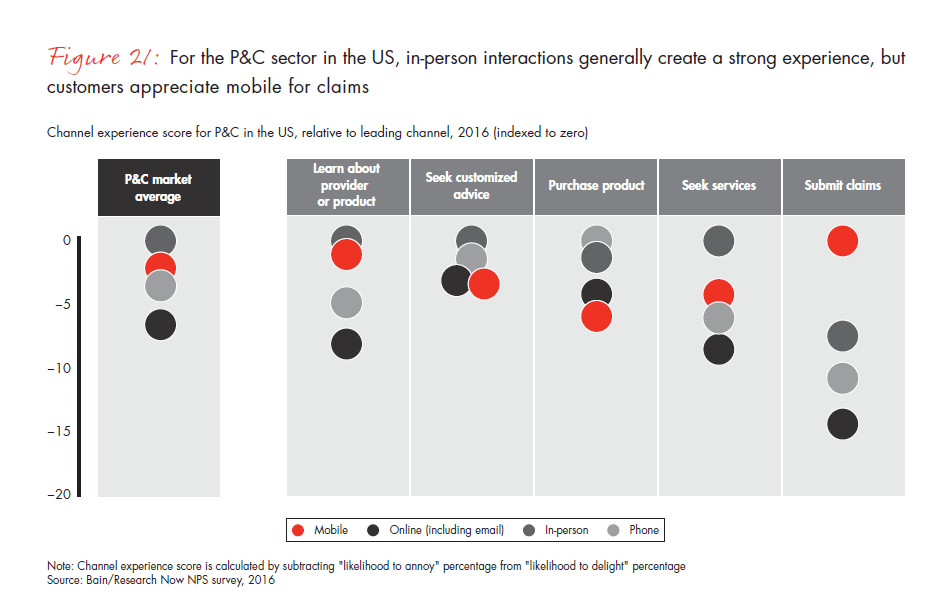
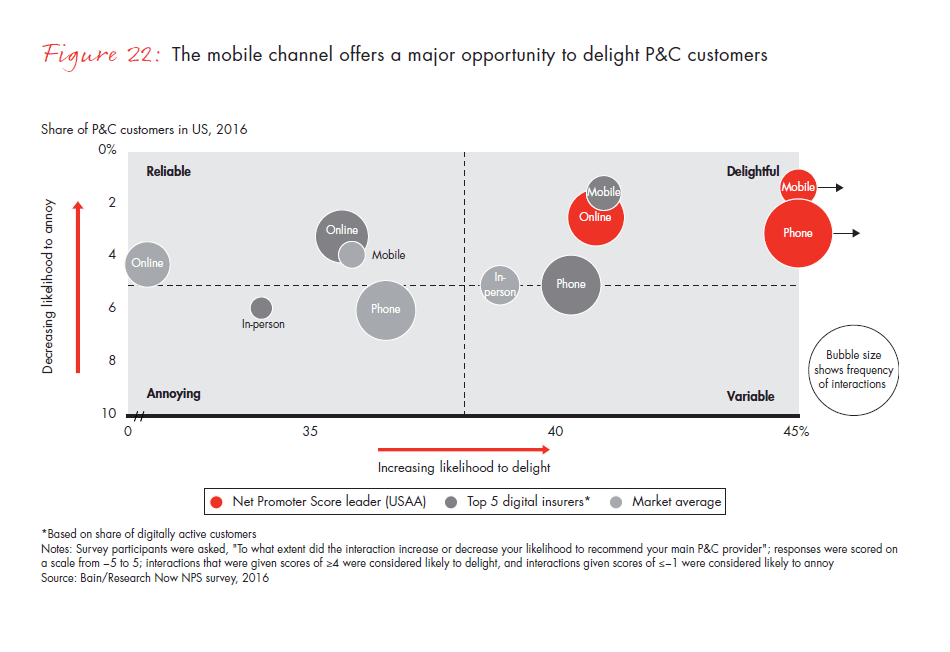
3. Mastering the customer-switching game in P&C
- In both auto and home, most new customers have switched from another carrier, rather than being first-time buyers. The UK, with its strong presence of aggregators, has by far the highest share of switchers among the people who bought a policy in the past year. Customer churn is most problematic for carriers in countries where an older demographic, combined with high insurance penetration, limits the number of first-time buyers.
- Insurers typically compete aggressively to acquire new customers or to retain current customers. Very few manage to excel in both activities, and some underperform in both.
- Before customers switch auto or home policies, they tend to engage in comparison shopping, which heightens competition and crimps profitability. Aggregator platforms have emerged in all markets, and they have become the main channel for comparison-shopping research in a few markets, such as Japan, Germany and the UK.
- Acquisition hinges on generating and converting leads, and many companies have ample room to improve in one or both of those activities to win their fair share of shoppers.
- Companies that lead in acquisition attract more price-sensitive customers than companies that excel in retention. These customers naturally are more difficult to retain, having high defection rates—up to 2.6 times that of other customers—as they hunt for the next price deal.
- Earning greater loyalty puts the brakes on defection, but as companies still need to acquire new customers, it’s essential for insurers to pursue three streams simultaneously: to attract and convert more customers who value peace of mind, to drive down the cost of acquisition and to give new customers good reasons to stay.
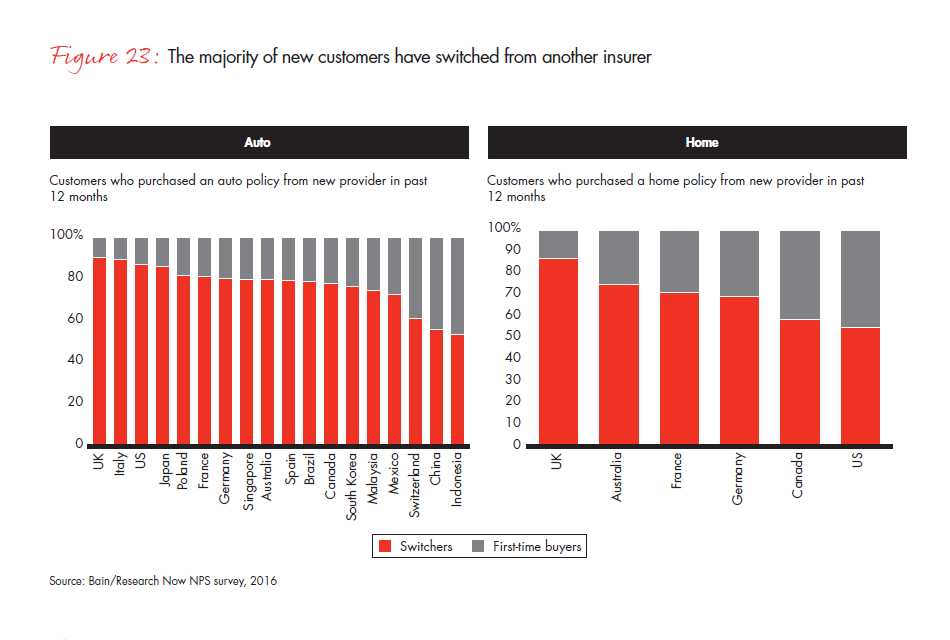
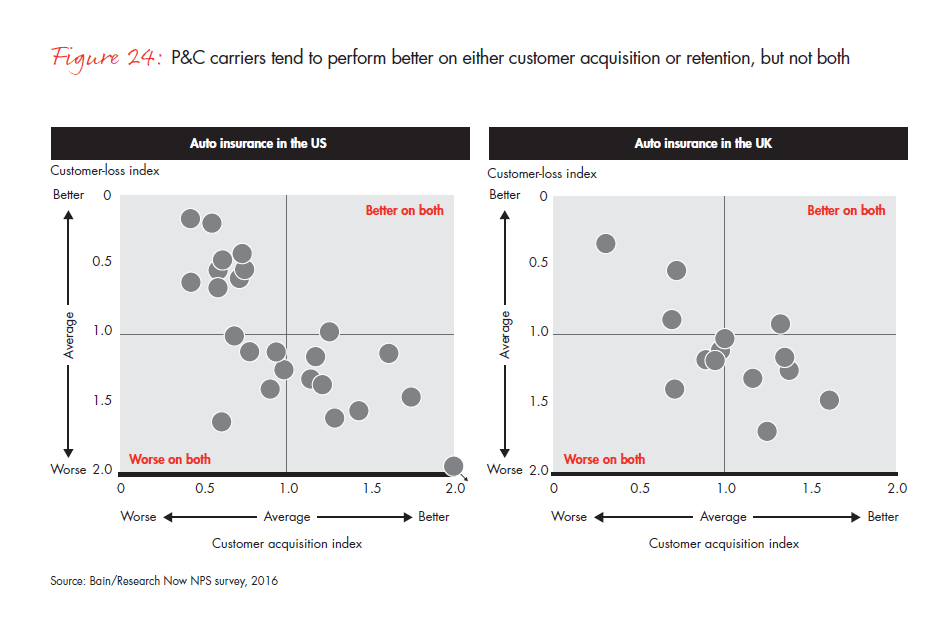
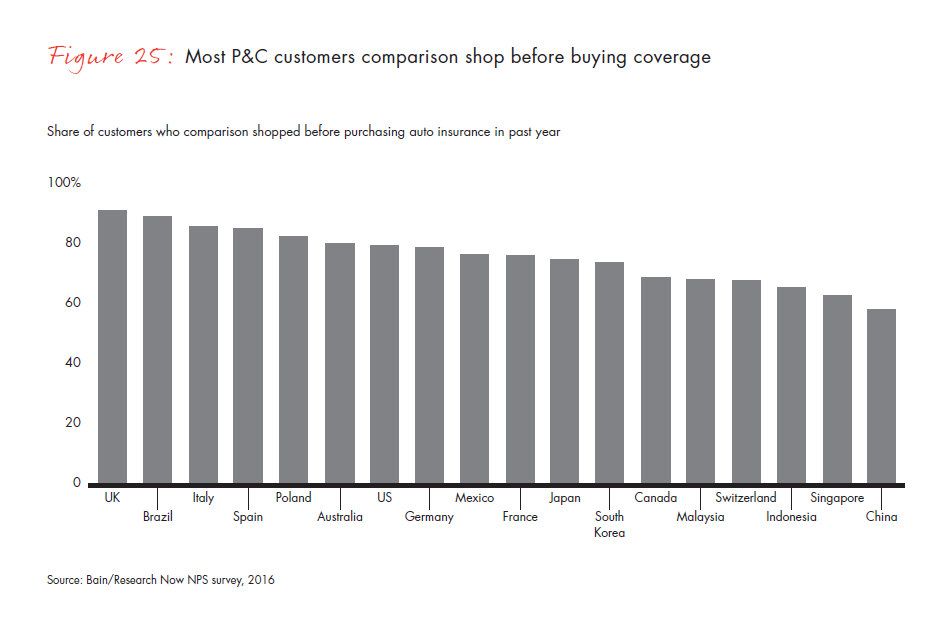
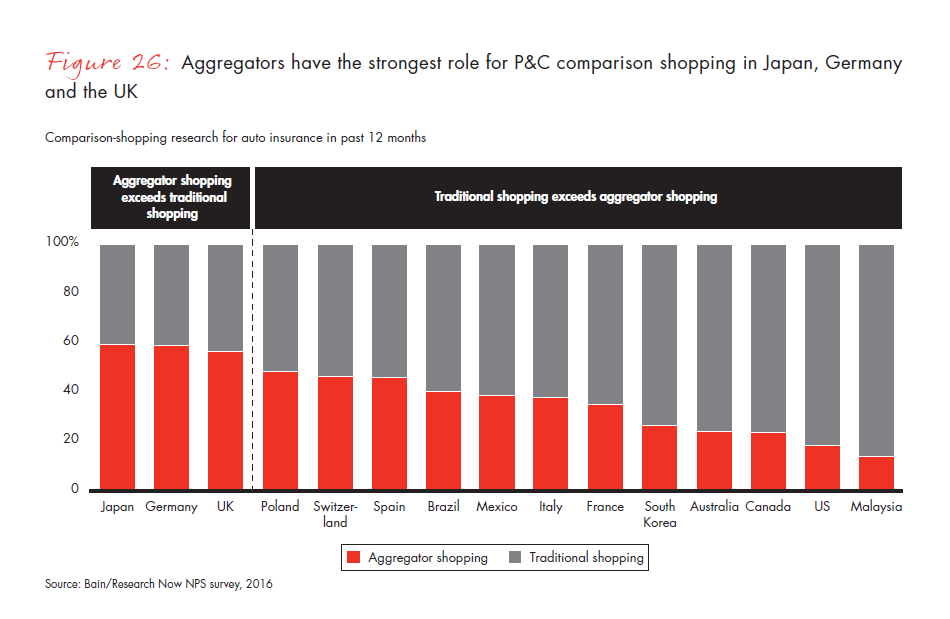
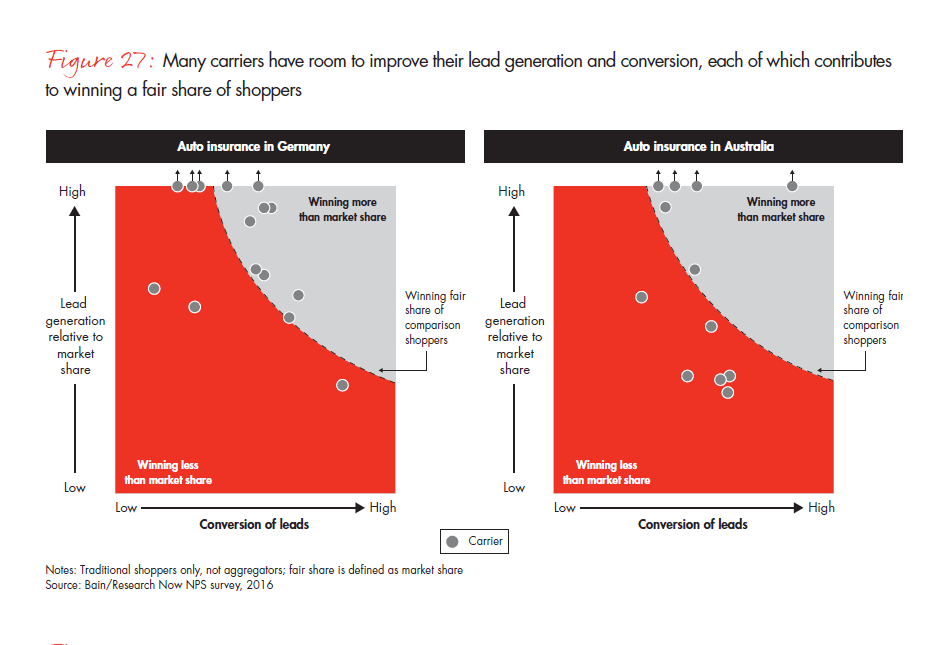
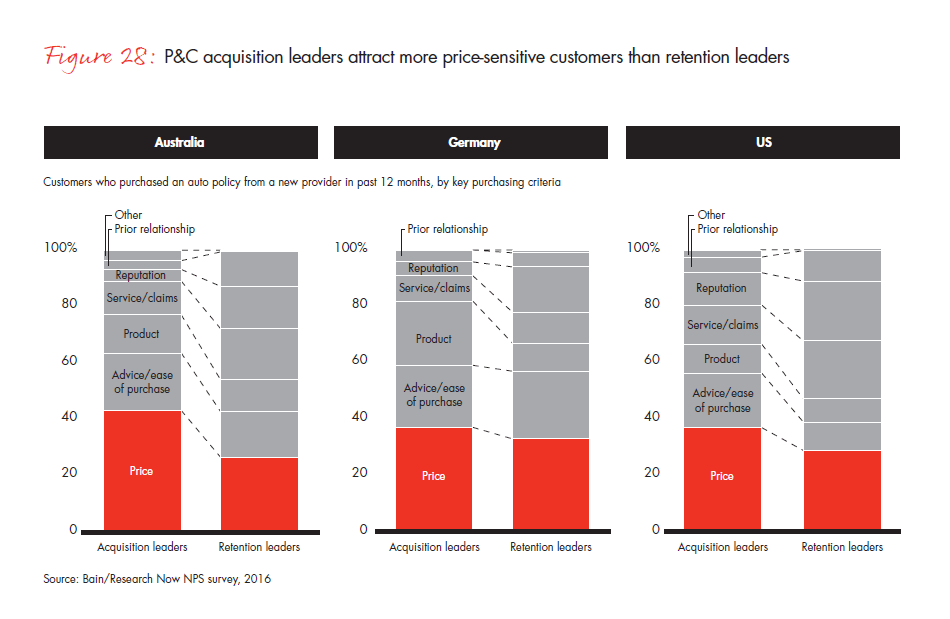
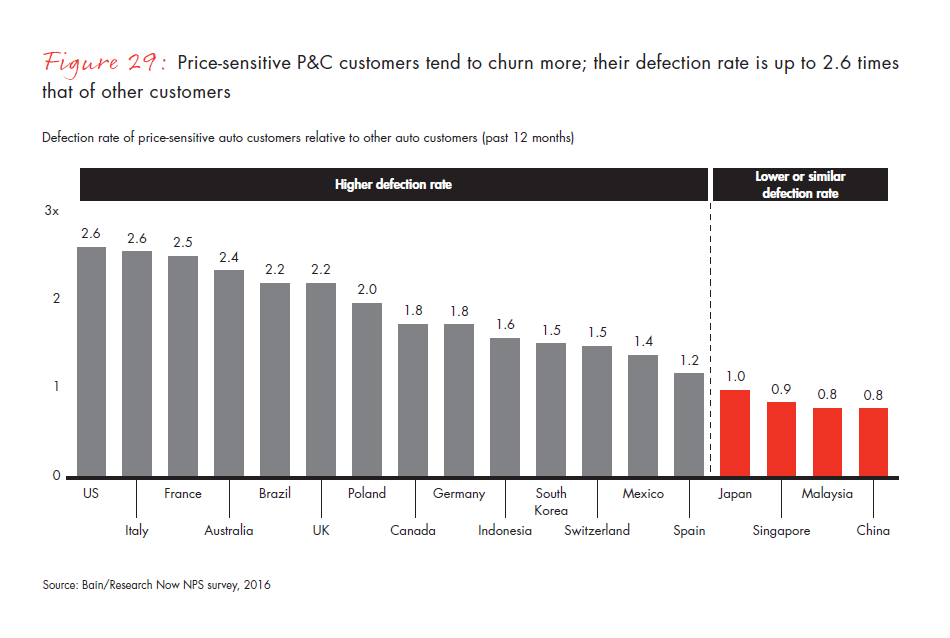
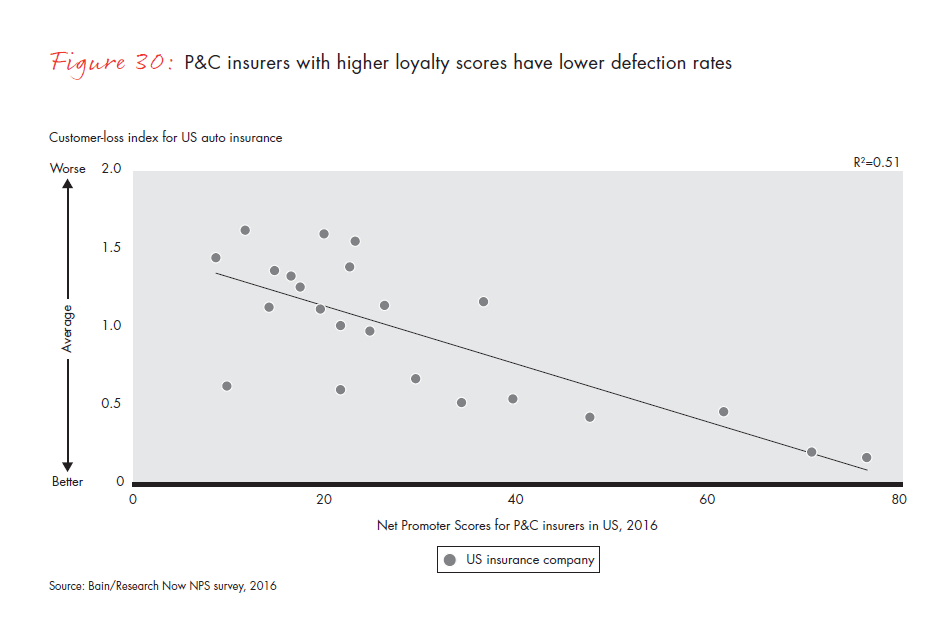
4. Capturing greater share of wallet
- Improvements in cross-selling can generate huge value in both P&C and life. Customers owning more insurance products stay longer, as evidenced by a much lower churn rate at any stage of the relationship for people who have multiple contracts relative to those with just one. And finding profitable growth through existing customers typically is easier and less expensive than acquiring new customers, and yields a higher return on investment.
- There is a massive gap between cross-selling leaders and laggards among P&C, life and multiline insurers in each country. Leaders sell up to twice as many products as laggards. The gap between multiline insurers is widest in Hong Kong, the US and France, and narrowest in Australia, Mexico and Switzerland.
- Opportunities abound to expand share of wallet. Many life insurance customers express a need for more coverage and more products, particularly in China, Indonesia, Malaysia and South Korea. Moreover, in most countries, the majority of customers are likely to buy from their primary insurers. Many carriers have earned the right to an additional sale—but they have to ask.
- Insurers have opportunities to engage with customers through live and digital channels. Many customers expect insurers to be proactive about contacting them with advice about such things as planning for savings and investments.
- Leaders in cross-selling often have higher loyalty scores, longer customer tenures and favorable customer demographics. Proficiency in cross-selling thus offers a route to growth: directly, by selling more products per customer, and indirectly, as customers with more products stay longer.
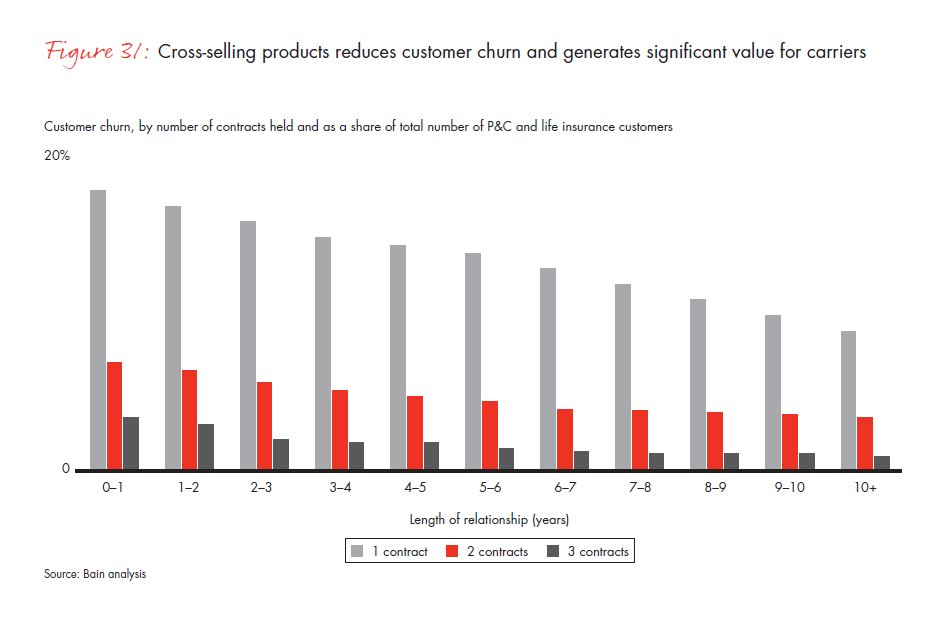
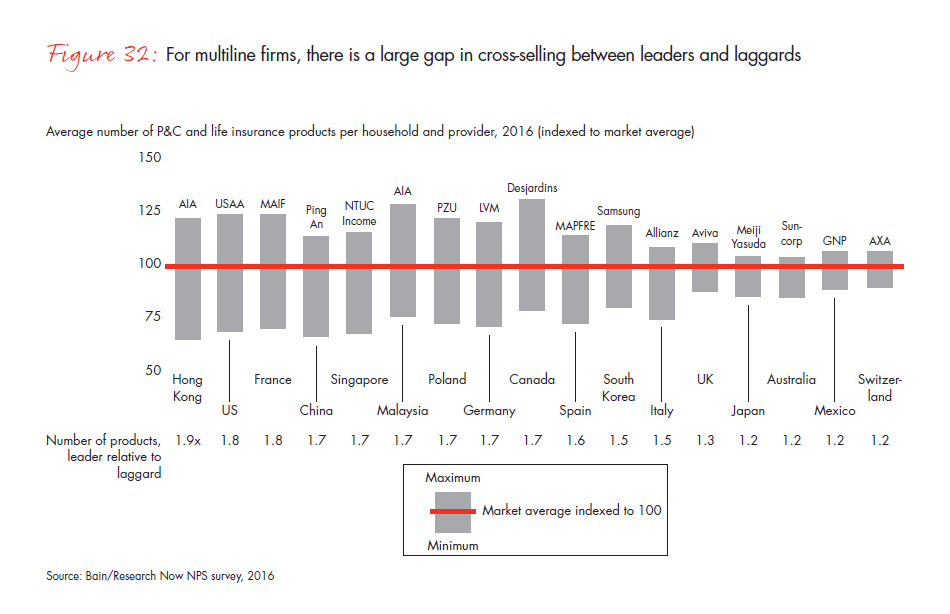
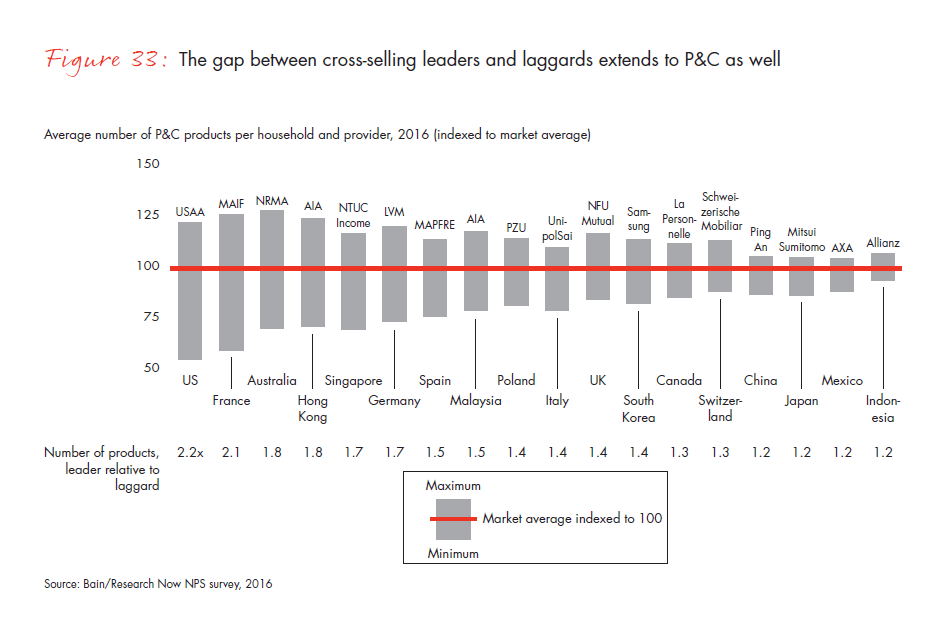
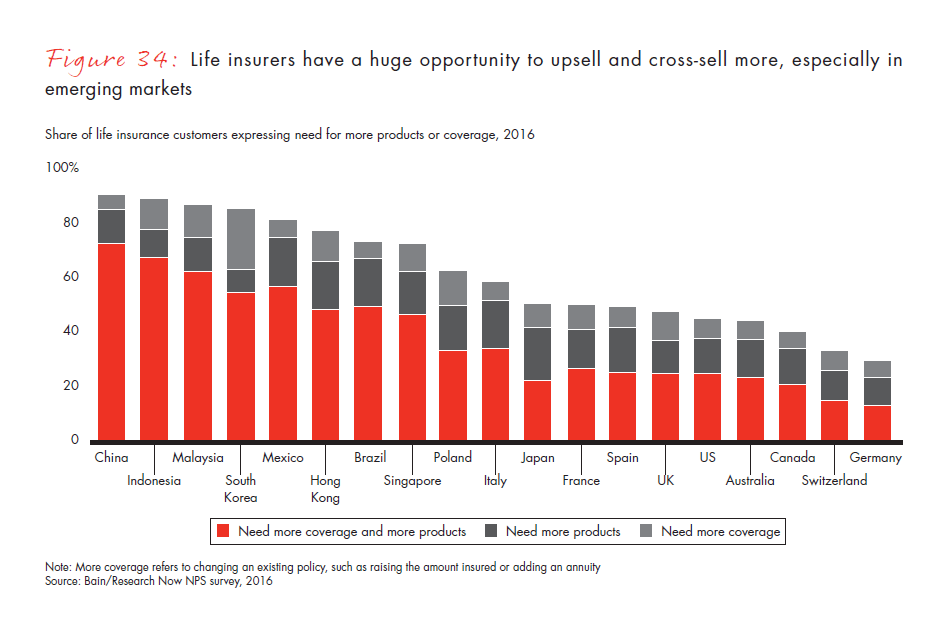
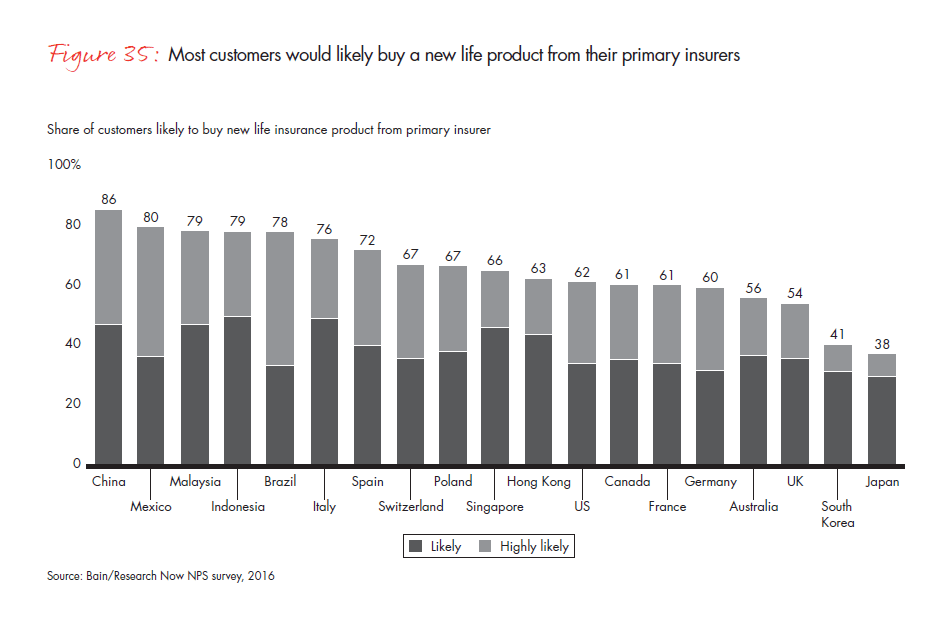
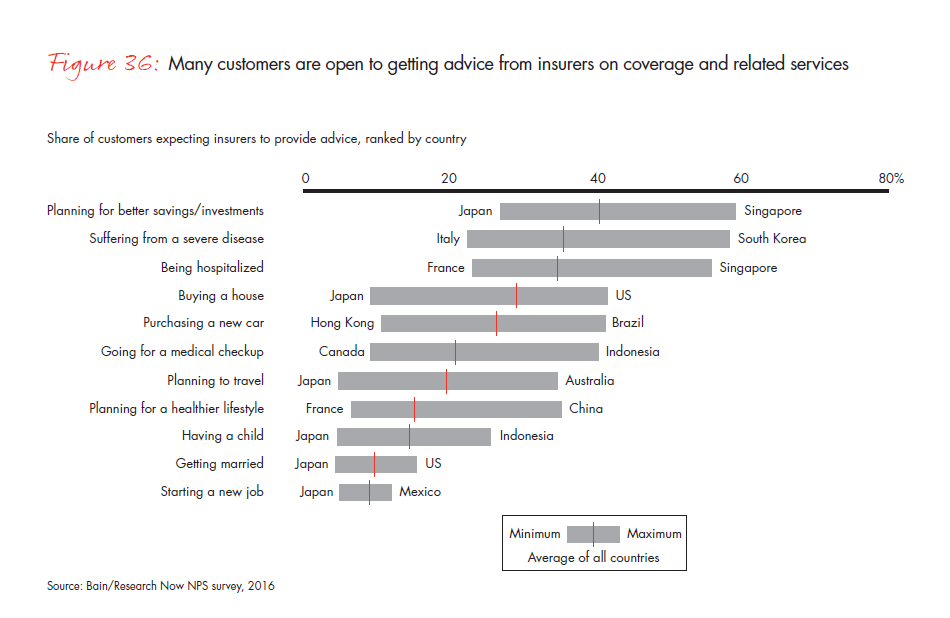
Appendix: Methodology
Bain & Company partnered with Research Now, the online global market research organization, to survey consumer panels in 19 countries: Australia, Brazil, Canada, China, France, Germany, Hong Kong, Indonesia, Italy, Japan, Malaysia, Mexico, Poland, Singapore, South Korea, Spain, Switzerland, the UK and the US. The survey’s purpose was to gauge P&C and life insurance customers’ loyalty to their main insurance providers and to understand the underlying reasons for their views. Conducted between March 2016 and June 2016, the survey polled 164,421 consumers of P&C and life insurance.
For our analysis of individual insurance providers, we included only those in the Americas, Australia and Europe that received at least 200 valid survey responses and those in Asia, Mexico and Poland that received at least 100 responses. In many cases, sample sizes exceeded these thresholds.
Survey questions
Respondents were first asked to list the P&C and life insurance products they purchased and to name the corresponding insurance providers. They then indicated their primary P&C and life insurance providers. Based on their responses, participants completed either the P&C or life insurance questionnaire.
They also responded to two questions to assess their loyalty to their primary insurance providers:
- On a scale of zero to 10, where zero represents “not at all likely” and 10 represents “extremely likely,” how likely are you to recommend your primary insurance provider to a friend or colleague?
- Why did you give your primary insurance provider the score you did?
Based on the scores they gave, respondents were classified as promoters (9–10), passives (7–8) or detractors (0–6). The Net Promoter Score® is the percentage of promoters minus the percentage of detractors.
We asked which channels respondents currently use for the following: to gather information about an insurance provider or insurance products, to seek advice, to purchase a product, to seek service and to submit and settle a claim. We then asked respondents how their channel usage had influenced their likelihood to recommend their primary insurance providers. We also asked whether they would be interested in platforms provided by insurers that offer ancillary services related to car, home, health and life. Finally, we asked participants about their willingness to share personal data with insurance companies.
In the survey, we included different questions for P&C respondents and life insurance respondents. We asked P&C respondents about switching behavior in auto and home insurance. For life insurance respondents, we included questions to understand the potential for cross-selling and upselling. Finally, we asked for demographic information: household income, age and region of residence.
The results of our data analysis are robust. Our measurements for insurance carriers’ Net Promoter Scores in each country and for respondents’ Net Promoter Scores for each demographic category were statistically significant. For each carrier, these scores were statistically significant to an 80% confidence level, with a one-tailed test ranging from ±1.3% (n=4,956) to ±10% (n=100).
This report was prepared by Henrik Naujoks, Camille Goossens, Gunther Schwarz, Harshveer Singh, Andrew Schwedel and David Whelan, who are partners with Bain’s Financial Services practice, and a team led by Tanja Brettel, a practice area director, and Shilpi Goel, a practice area consultant. Team members are Rahul Agarwal, Vidisha Agarwal, Sourish Gue, Vaibhav Kalani and Pranav Singh. The authors thank Bain partners in each of the countries covered in the report for their valuable input and John Campbell for his editorial support.
Net Promoter Score® is a registered trademark of Bain & Company, Inc., Fred Reichheld and Satmetrix Systems, Inc.



































